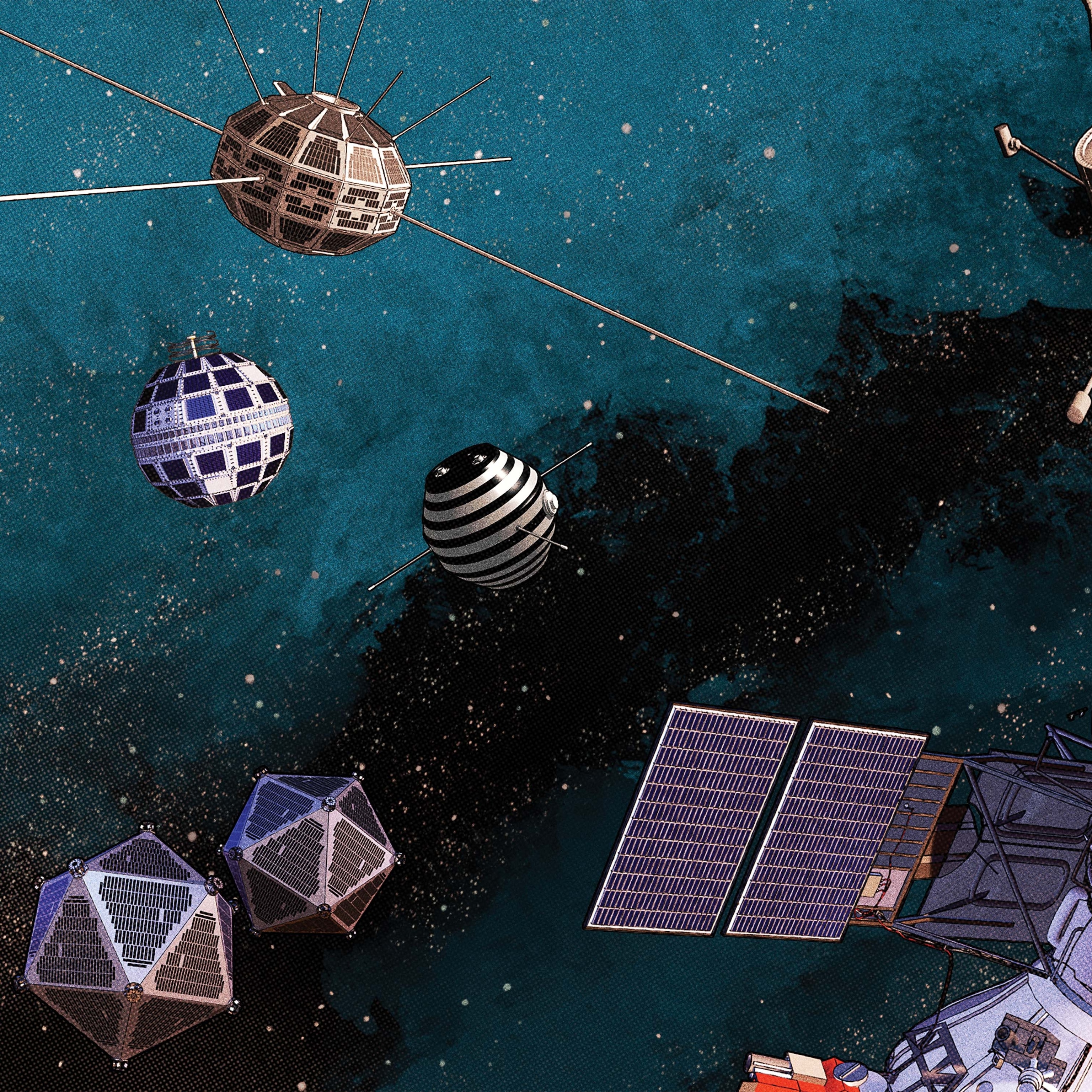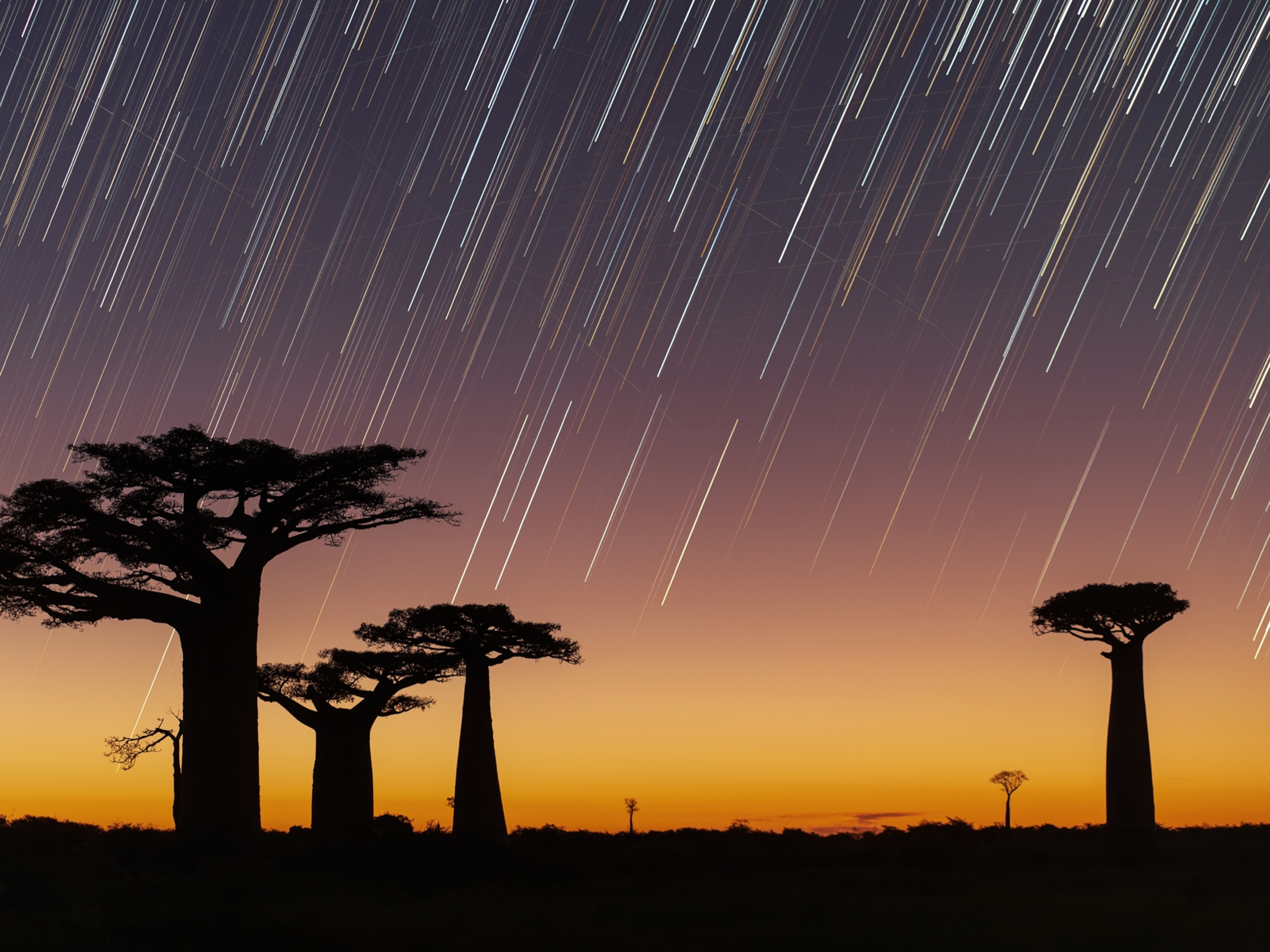
The birthplace of the space age isn’t where you think
Scientists riding balloons in a remote region of the U.S. collected vital data used by NASA to get humans into orbit.
One thing is clear: No one is going ballooning today.
It is 6 a.m. on a recent Friday. I am standing amid a few dozen folks shivering in the early morning chill at a highway rest stop in the Black Hills, just west of Rapid City, South Dakota. Our heads are all tilted upward, our eyes squinting to keep sight of a tiny black dot—a small helium balloon released a few moments ago by Mark West, a tall, silver-haired fellow whose usual easy smile has turned to a tight-lipped frown.
“It’s going in the wrong direction,” he says. “That’ll take us to Mount Rushmore.” And there’s more bad news when he calls the Rapid City National Weather Service on his cell phone: The previous night’s rains, while abating somewhat, will hang around.
A knot of us—just about all wearing face masks as the COVID-19 pandemic stretches into the month of September—gather around to eavesdrop on the conversation.
“I would definitely not recommend going up this morning,” West finally announces. And he should know—he’s president of the Balloon Federation of America. But as I glance around, the crowd seems surprisingly upbeat.
“Okay,” comes a voice from the pack. “We’re gonna go down into the bowl to play.”
“The bowl” is a rock-walled, 450-foot-deep natural pit that yawns just a few yards from this highway pullout. Beyond a stand of trees, the land suddenly drops away into a sheer, semi-circular rocky chasm. At its base lies a large circular meadow protected from wind—a hot-air balloonist’s paradise.
Since 1934, the spot has been known as the Stratobowl. In a two-year blizzard of activity, scientists from the U.S. Army Air Corps and the National Geographic Society gathered here, taking advantage of those protective granite walls and the site’s 4,000-foot elevation, to launch humans into the stratosphere for the first time. Huddled inside a modified version of the bathyspheres that oceanographers were using to explore the depths of the ocean, teams strapped themselves to insanely huge balloons, filled first with hydrogen, later with helium. Casting off their ropes, they lurched to unheard-of heights before descending to dangerous, barely controlled landings hundreds of miles away. (Follow along the world's first bathysphere dive to unexplored depths in 1931.)

Using data from those early ascents—as well as later Stratobowl balloon launches in the late 1950s—NASA and its predecessors studied the survivability of ultra-high-altitude travel. It is no exaggeration to say that the space age began inside the Stratobowl.
Now, each year in September, a dedicated group of balloonists returns to the bowl to commemorate those primal pinpricks in Earth’s upper atmosphere. On Friday, Saturday, and Sunday after Labor Day, as the balloonists gather at the bottom of the Stratobowl, thousands of onlookers peer from vantage points around its rim, marveling at the sight of hot-air balloons rising from below, lingering at eye-level, then sailing off overhead as they catch a puff of wind.
On this rainy Friday, the spectators will be disappointed. But for balloonists, the Stratobowl offers a unique consolation prize: They can head down to the bowl floor, inflate their balloons, and “play”—rising to a hundred feet or so, tethered to the bumpers of the trucks they use to haul their gear.
Besides, as one balloonist tells me, “We’ll get ‘em tomorrow.” He pauses, then adds, “Or the day after that.”
Peace rising
As the die-hard balloonists depart in a caravan down the twisting, unpaved road that leads to the bowl’s bottom, I opt to take a hike along the unmarked Stratobowl Rim Trail. Even on this cloudy morning, the view is staggering. Far below, two determined balloonists have already inflated their colorful craft and are gently rising and falling, like flowers floating on invisible waves. Also drifting up from the floor is the faint gurgling of Spring Creek, which meanders through the semicircular bowl and empties through a small tree-lined canyon.
As the rising sun illuminates the valley floor, I notice a not-so-natural feature of the Stratobowl: an enormous 1960s peace sign mowed into the grass. It’s the handiwork of the man who owns this little bit of hot-air-balloon heaven, Ken Tomovick.
“I cut that peace sign into the grass around 2008,” says Tomovick. “I had a few reasons to do it. One was to recognize my brother, who was severely wounded in Vietnam.”
We are sitting on the back porch of Tomovick’s rustic house, just a few feet from the bowl’s grassy clearing. His family has owned land down here for generations, and his plot happens to include the historic balloon launching field.
A retired professional plane and helicopter aviator, Tomovick has, ironically, never piloted a hot air balloon. But he treasures the bowl’s aviation history, and loves to wander among the balloons and their scurrying launch teams, occasionally stopping to help pull a rope or hold a balloon envelope open as a large fan fills it with air.
“It’s just the way Ken is,” says his wife, Cory, gently touching his arm. “There’s just this part of him that wants to share this place with the world.”
For years, Tomovick was part of a protracted effort to get the Stratobowl declared a national historic site. It would have happened, but the designation was blocked by neighbors who, he says with some exasperation, are not fans of ballooning.
“That might be another reason I carved that peace sign out there,” he says, smiling wryly and envisioning the contrarian neighbors sputtering at his silent message of peace and generosity every time they look out their back window.
Near disaster
It is 6 a.m. Saturday. I emerge from my hotel delighted to see stars twinkling in a dark, clear sky.
“Today we balloon!” I tell myself. Then I discover a text message from Kay West, who along with her husband, Mark—the guy with a hotline to the Weather Service—began this yearly ritual in 2010.
“Rain showers east of us,” she writes. “Likely won’t fly. But will tether in the bowl.”
This time I join in the festivities on the Stratobowl floor, walking with Kay among five balloons in various stages of inflation. One of the sport’s top pilots and a nationally recognized instructor, Kay has been running Black Hills Balloons since 1984. She’s expecting up to a dozen balloonists to participate in this year’s full-fledged launch—if it ever happens. “We’ve never had a complete wash-out,” she says confidently.
I hitch short rides with a few generous balloonists. Tethered at this elevated vantage point, my view takes in the entire bowl, from its grassy floor to its rocky rim, wispy morning fog clinging to the cliffs. It’s easy to imagine this place bustling with activity in the mid-1930s, the electricity of scientific endeavor crackling around its sheer walls.

The National Geographic Society’s board had decided in 1933 that instead of simply reporting on the world’s great ballooning adventures, they would mount a high-altitude aerial expedition of their own. Within months the Society had settled on the Stratobowl site, largely thanks to its proximity to a major road and the high, sheer walls, which would shield the huge balloon from damaging winds during inflation.
Partnering with the U.S. Army Air Corps, the Society commissioned Dow Chemical to build a spherical gondola made of Dowmetal, a material lighter than aluminum. The craft would accommodate three men plus scientific equipment to measure barometric pressure, altitude—and, in an almost prescient nod to the future concerns of space travel, cosmic rays.
The craft came on flatbed truck from Michigan. The enormous balloon, to be filled with 35,000 cubic feet of hydrogen, arrived in a crate from the Goodyear-Zeppelin plant in Akron, Ohio.
The craft, called Explorer, took off without a hitch around 5 a.m. on July 28, 1934. But things went south by the time the three-man crew reached 60,000 feet.
“A small rope fell from the bag and clattered on top of the gondola,” wrote crewman Capt. Albert Stevens. “Through the port I looked up, startled, to see the large rip in the balloon’s lower surface.”
Soon the men were plunging to Earth, the remnants of the balloon acting like a pitifully inefficient parachute—nevertheless “a pretty sight,” Stevens observed.
Barely 6,000 feet above Nebraska, some flapping piece of material must have caused a spark, because the remaining hydrogen did what hydrogen does: It exploded. The three men, with only seconds to spare, jumped free and parachuted safely to Earth while Explorer, in Stevens’s words, “hit with a tremendous thud.”
Almost immediately, National Geographic commissioned the construction of Explorer II, with one major change: helium instead of hydrogen. And lest Society members think their $3.50 annual dues were being frittered away, President Gilbert H. Grosvenor assured them, “The financial loss resulting from the explosion of the balloon and the crash of the gondola was much reduced by insurance.”

Explorer II rose from the Stratobowl at around 7 a.m. on November 11, 1935. At 11:40 a.m. the craft topped out at 72,395 feet, nearly 14 miles above sea level—a new record. The two-man crew snapped a photo encompassing thousands of square miles, from the Bighorn Mountains of Wyoming to the farms and ranches that spread southeast from Rapid City.
“Sunlight sparkled from rivers and lakes, but we saw no sign of life,” wrote Stevens, testing fate by once more heading aloft. “It seemed a foreign and lifeless world.” To Stevens, the sight so familiar to the millions of us who travel in airliners each year was as unfamiliar as a Mars scape.
And there was something else visible in that photo: the wide, lazy arc of the horizon. It was the first-ever photograph of the curvature of the Earth.
Explorer II came to Earth 225 miles to the east. This time, Stevens said, it was an “eggshell landing.”
Both Explorer launches were a sensation in Rapid City and beyond. Between 25,000 and 30,000 onlookers turned out for each one, teetering on the clifftop above or seated in a ticketed gallery on the bowl’s floor. NBC radio broadcast the Explorer II launch live to a worldwide audience as far away as South Africa.
In the 1950s, the U.S. Navy would return to the Stratobowl with Project Strato-Lab, setting new ballooning altitude records and developing technology for NASA’s Project Mercury space suits. But those feats never matched the high-flying frenzy that surrounded Explorer I and II.
“For that generation, this was their Project Mercury,” says Mark West. “It was their moon landing. Not only had Rapid City never seen anything like this—the world had never seen anything like it.”
Aloft at last
It is 6 a.m. Sunday. I notice, with Groundhog Day-inspired trepidation, the sky looks much as it did yesterday.
At the highway pullout, Mark West is releasing today’s black balloon. It rises lazily, then abruptly shoots off to the southeast—away from Mount Rushmore, at least, but the speed of its departure seems worrying to all.
Mark calls the Weather Service, and the news is not great: Although the wind here at ground level seems calm, on high is a traffic jam of swirling, unpredictable air currents.
“Well,” sighs Kay, “better to be down here wishing you were up there than to be up there wishing you were down here.” I later learn it’s an old balloonist adage.
“But we’ve never been totally shut out all three days,” comes a voice.
“I know,” says Kay. “There’s only one thing that’s different this year…”
I am suddenly aware that every eye in that dark parking lot has turned to me.
“Sure,” I say. “Let’s find a volcano and you can sacrifice me to the wind gods.”
Kay has one more question for the Weather Service guy: How thick is the layer of calmer air before you get to the upper level turbulence?
“Uh…about 1,800 feet,” he says.
Every face around me lights up.
“If that holds, that’s plenty!” Kay exclaims, and soon everybody is scrambling to their trucks to haul their balloons to the Stratobowl floor.
“It’s not his fault,” says Kay of the Weather Service guy’s prematurely negative outlook. “Not all those guys know ballooning.”
Soon I’m ascending from the Stratobowl floor, the rocky wall sliding by vertically, like the interior of a stone elevator shaft. Kay is piloting the craft, while Ken Tomovick and I take in the view and try to stay out of her way. Despite his intimate involvement in the event, Tomovick hasn’t been up in a balloon in years, and he seems almost as excited as I am.
With a flash, the sun washes over us as we clear the rim. Moments later we feel a sharp tug as the wind pushes us east. It’s not unlike the feeling of hitting the gas as you come off an interstate highway onramp.
Our flock of balloons stretches for miles. The silence about a thousand feet up is surprising. I’d expected the wind to be rushing by us, but of course we are one with the wind. Behind us, in the Black Hills, the profile of George Washington peers out from Mount Rushmore National Memorial, which at the time of the first Stratobowl launch was just taking shape atop the mountain the Lakota Sioux called Tuŋkášila Šákpe, or the Six Grandfathers.
As the hills give way to rolling ranchland, a small herd of cattle lows to our right. I’m reminded that not all the ranchers around here are enamored with balloons. Some insist the colorful globes soaring overhead scare their cattle, although the ones I’m looking at right now couldn’t seem to care less.
Our pilot Kay isn’t paying much attention to the sights. She focuses on the other balloons dead ahead of us, discerning which way the wind is blowing and reckoning whether she should stay at their level or change altitude in search of more favorable winds.
“There are balloon pilots,” she says, “and there are people who just take up a balloon and look pretty.”
After a half-hour or so aloft, the other balloons are starting to land, and Kay spots a likely site for us along a road about eight miles from where we started. Alternately firing up the balloon's gas burner and releasing hot air through the vents up top, she skirts a low hill of prairie grass, then pops us back up just long enough to hop a wire fence at about three mph. I can’t help but think of Neil Armstrong and Buzz Aldrin skipping over boulders and craters as they searched out a safe landing spot on the surface of the moon.
We come to rest, as if lowered by an invisible hand, directly on the shoulder of a country road. The Eagle has landed.
It is near midnight. The dark walls of the Stratobowl frame a canvas of impossibly bright stars. It was here that humans took their first significant steps toward those stars, toward seeing themselves as citizens not just of Earth, but of the cosmos as well.
Two decades would pass before humans challenged Explorer II’s high-flying records. In 1954 a U.S. Air Force X2 jet finally smashed its altitude mark, nearly doubling it. Seven years after that, the Soviet Union’s Yuri Gagarin became the first human to break the bonds of Earth and slip into orbit.
And today, billions of miles away, the interstellar spacecraft Voyager II sets a new altitude record every second. Among its continuing tasks: measuring cosmic rays, building on a data set begun nearly 90 years ago in a balloon launched to the edge of space from a grassy meadow in a rocky bowl.








